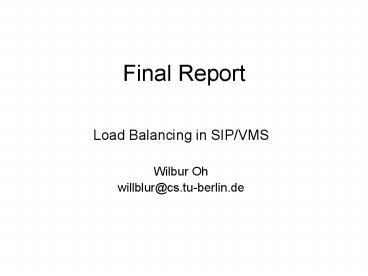Final Report - PowerPoint PPT Presentation
1 / 13
Title:
Final Report
Description:
SIP/VMS system records voice messages over IP telephony ... SIP/VMS UA handles the SIP request and also to ... Midcom requirements (from Swale et. al. ... – PowerPoint PPT presentation
Number of Views:437
Avg rating:3.0/5.0
Title: Final Report
1
Final Report
- Load Balancing in SIP/VMS
- Wilbur Oh
- willblur_at_cs.tu-berlin.de
2
Overview
- Introduction
- Requirements
- Policy Language
- System Model
- Behavior Definitions
- Conclusions
3
Introduction
- SIP/VMS system records voice messages over IP
telephony - Main components are SER, SIP/VMS UA and VMS
- SER is sued to receive SIP calls
- SIP/VMS UA handles the SIP request and also to
communicate with the VMS - VMS used to handle the recoding of the message
- Load Balancing required in two areas
- The selection of a SIP/VMS UA
- The selection of a VMS ( if more than one is used)
4
Requirements
- General requirements
- Resource availability must be reliable at SER
(GEN Agent), if no resource are available caller
must be notified. - GEN must not affect AIP and VMS original
behaviors such as failure notification - Extra configuration for emergency calls
- Midcom requirements (from Swale et. al.)
- The Midcom protocol must enable the middlebov and
any associated Midcom agents to establish known
and stable state - The middle box should be able to report its
status to a Midcom agent with which it is
associated
5
Requirements
- Midcom requirements
- A Midcom must be able to determine whether or not
a request was successful - The Midcom protocol must support the ability of
an agent to install a ruleset that governs
multiple types of middlebox actions (e.g.
firewall and NAT) - Load balancing requirements
- Only one SIP UA can handle only one SIP session
at any one time - The distribution of load to a GEN agent should be
fair and there should not be any hard-wired
relation between SIP UA and SER - Selection of SIP UA should be independent on the
number of entities
6
Policy Language
- Created by Solomon and Lupu
- Policy language approach to program network
components - Make the configuration of the components more
dynamic - Language is in 2 categories
- Authorization policies controls access policies
to protect resources from unauthorized access - Obligation policies determine what activates a
subject is allowed to perform - Authorization policies can be used for
configuration phase and Obligation policies used
to determine load balancing behaviors
7
System Model
- High Level View
8
System Model
- Traditional solution for SIP and VMS integration
9
System Model
- GEN based with load balancing
10
System Model
- BD is processed, eligible SIP UA apply to join
group, first group message is sent. - All SIP UA constantly listening at SGCC, NEXT is
chosen, second group message is sent. - It contains all the group members and identity of
NEXT
11
System Model
- Significance of NEXT is that it is the elected
leader to handle the session. NEXT sends
InviteAck to show it is the call-handler - During passing of NEXT, there is a timeout period
to remove crashed members.
12
Behavior Definitions
13
Conclusions
- Traditional solution is not dynamic
- Addition and removal of SIP UA requires a
reconfiguration of the system - It has selection latency because it has to go
through a database to find a suitable SIP UA - GEN-based model does not need reconfiguration
when SIP UA are removed or added (self-organizing
behavior) - It will also have a smaller selection latency
with a NEXT available strategy































